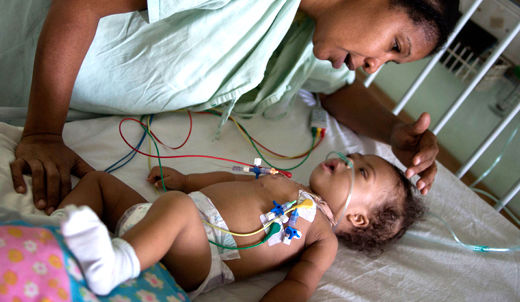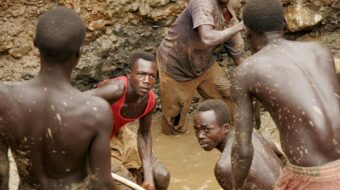
It’s totally unnecessary, but somewhere in Cuba a small child is undergoing risky open-heart surgery. This is because the U.S. Congress refuses to lift the blockade that would allow Cuban pediatric hospitals to purchase a device that would make it possible to treat her heart conditionwith a safer and less painful procedure.This is just one example of the many cruel and senseless effects of the U.S. blockade of Cuba.
But human rights advocates are hopeful that although only Congress can end the blockade, it may be possible for President Obama to use his broad executive powers to bypass many of its most egregious provisions.
Although Cuba’s socialist society guarantees all Cubansfree high-quality health care, some patients suffer as a result of U.S.international trade restrictions which deny them medical equipment and supplies, according to a report publishedthis summer by Cuba’s Ministry of Foreign Affairs.
The report, issuedin support of a UN resolution for “ending of the economic, commercial and financial blockade imposed by the United States of America against Cuba,” documents the ongoing impact of the 56-year blockade. Miguel Fraga, First Secretary of the Cuban Embassy of the United States explained that the extensive report on the real life impact of the blockade was compiled from institutions across the island.
The blockade bars Cuban access to not only U.S.-made devices and medicines, but also to those manufactured in other countries. For example, Cubans suffering from rheumatoid arthritis can’t get prostheses needed to surgically replace damaged wrist joints. The manufacturer of the artificial joints,multi-national SBI,has 22 European branchesbut not one of them will sell to Cuban hospitals. The blockadeforbids subsidiaries of U.S. companies, even when their manufacturing and sales take place thousands of miles from U.S. borders, from selling any products to Cuba – even food and medicine.
Treatment and research blocked
Cuban doctors say that care of patients with muscular sclerosis and Parkinson’s disease is compromised because their supply of EMG equipment was cut off when its manufacturer, the Canadian firm Xltek, was bought by the U.S.companyNatus Medical in 2007.
Clinical studies of hereditary breast cancer, cystic fibrosis, mitochondrial disease and retinitis pigmentosa at Cuba’s National Center for Genetic Medicine were blocked when the U.S. firm Applied Biosystems refused Cuba’s request to purchaseits Genetic Analyzer. The same determined researchers faced still another roadblock whenamulti-national medical technology firm,Qiagen,bought out the Danish firm CLCBio. CLC Bio had provided free access to software to view gene sequencing. But Qiagen denied Cuban researchers access to program updates. Qiagen explained that the blockade of Cuba prohibited them from providing technical support,services and software licenses.
The Foreign Ministry’s report points out that software is increasingly an issue for modern medicine. Most medical imaging equipment is run oncomputers based on the Windows XP operating system. Cuba’s National Electro Medicine Center reports that Windows XP requires activation by Microsoft, but since none of the activation options are available in Cuba, technicians have to waste their resources coming up with extreme and creative work-arounds while patients wait and too often suffer.
The Cuban government estimates that it had to set aside $75 million annually from its health care budget to cover the additional health care costs imposed by the blockade over the last year alone. This total does not include the humanitarian repercussions when spare parts for medical equipment and supplies have to be attained through third parties across the globe resulting inpainful and potentially tragic delays in treatment.
U.S. officials refer to the policy as an embargo, but human rights advocates call it a blockade. The difference is not just semantic.
An embargo is a trade restriction from one country to another, but a blockade isan act of sealing off a nation to prevent goods from allother countries from entering or leaving. U.S. policy not only restricts the trade of companies and people under the jurisdiction of the U.S. Congress, but also levies sanctions and effectively prohibits trade of other countries and their citizens with Cuba. This policy is in fact a blockade.
A burden no other country bears
Cuba is a developing country that suffered for decades under the heel of U.S. corporations such as United Fruit. While these corporations sucked resources out of the island – sugar, rum, nickel – the only infrastructure they built was to support that one -way street – a single rail line and highway connected to ports, a one-industry economy. Whole cities and provinces lacked hospitals and schools.Besides gambling, no domestic industry was developed – even candy was imported to neo-colonial Cuba.
In the nearly 60 years since the Cuban people took control of their nation remarkable progress has been made in addressing this legacy of deliberate underdevelopment, but the Cuban economy also shoulders a burden not carried by any other economy in the world – a punitive blockade which has added enormous costs to every undertaking for decades.
The Foreign Ministry reportcites $120 billionas the cost of the blockade since its inception.
How does the blockade work?
The blockade sounds like it’s just a matter between the United States and Cuba but it’s not. In fact, its stranglehold severely limits Cuban society’s access to the entire world market of food, medicine, industrial machinery, building materials and communications technology produced by thousands of companies and millions of workers in other countries around the world.
The blockade is a poisonous web of penalties against those who break its rules. A dozen or so laws, including the 1992 TorricellliAct and the 1996 Helms-Burton Act weave together its toxic strands.
Here’s how it works: In today’s global economy, credit is the standard means of payment and companies are bought and sold across borders. The blockade’s web of regulations can impose huge fines on financial institutions that offer that credit or conduct business with Cuba, including financial institutions not only inside but also outside our country’s borders.
The blockade’s stranglehold preventstrade. Any ship that lands in Cuba is barred from U.S. ports for 180 days.
Even when manufactured by a non -U.S. company, any manufactured product which is judged to contain more than 25 percentparts originating in the U.S. may not be sold to a Cuban company.
How does the U.S. enforce the blockade? Not through gunships but through a U.S. government agency, theOffice of Foreign Assets Control (OFAC) of the Department of the Treasury.With a multi-million dollar budget, OFAC agents use sophisticated computer programs to find and persecute its prey – those anywhere in the world having business dealings with Cuba.
OFAC, the poison spider who minds the web, is the enforcer. Itassesses multi-million dollar fines on both U.S. and foreign entities and individuals discovered exporting or importingproducts to Cuba.
Here are some examplesfrom the past year:
In March, Commerzbank of Germany was required to pay a fine of $1.71 billion. It processed 56 transactions related with Cuba for $2,284,456. Cuban funds are now frozen in that bank and other European banks have refused to do business with Cuba, resulting in Cuba being unable to make foreign payments during the last nine months;
Also in March, PayPal was fined $7,658,300 for processing 98 transactions with Cubans. The transactions themselves only totaled $19,344;
Sigma Aldrich, one of the world’s largest chemical firms with operations in 40 countries refused to provide the Cuban chemical firm Quimimpex with essential chemical products. It explained that it could not provide products, servicesnor technical information from any of its facilities regardless of their locations.
Some of the harassment is unbelievably petty. U.S. tax dollars apparently funded the research that led to the OFAC requiring a Costco outlet in Japan to suspend the membership of a Cuban embassy employee there.
The recent restoral of diplomatic relations does not affect the blockade. Lifting the blockade would require an act of Congress. However, significant discretion in the blockade’simplementationis available to the President, who in this year’s State of the Union address urged Congress to “begin the work of ending the embargo.”
The President has significant power to dismantle the majority of the restrictions imposed by the laws that make up the blockade. To begin with, the president has the executive prerogative to instruct U.S.representatives in international financial institutions not to obstruct the granting of loans to Cuban financial facilities.
The President can also:authorize exports of U.S. products to Cuba;permit the use of the U.S. dollar in Cuba’s international transactions; allow such transactions to be carried out through the U.S. banking system; allow Cuban entities to open accounts in U.S. banks; and authorize Cuban aircraft and ships to transport travelers, cargo and mail between the two countries.
The President could end the ban on Cuba importing products that contain more than 25 percent of U.S. components; allow import of tobacco, rum, andbiotechnological products from Cuba to the U.S.;authorize U.S. firms to make investments in Cuba; authorize U.S. citizens to receive medical treatment in Cuba; permit the granting of credits, loans and financing in general to acquireproducts on the U.S. market (except for agricultural products, which are explicitly prohibited by a 2000 law).
Ironically, most of these powers come through the odious Helms Burton Act which reserves to the president the power to grant licenses for most of the otherwise prohibited activities.
Support by the U.S. people for friendly relations with its island neighbor is overwhelming, so if President Obama takes advantage of the powers reserved to him to begin dismantling the blockade it is unlikely that there would be support for its reinstatement. Many jobs are already being created by midwest exports of chicken and grain to Cuban consumers. U.S. patients and health care providers would like access to medical innovations like the new vaccines to treat hepatitis and lung cancer thatCuban bioscience labs are producing. And when winter winds are whipping our northern cities come February, many would-be tourists will be longingly eyeing sunny Caribbean beaches.
Photo: One-year-old Eduardo is comforted by his mother in the recovery room after his heart operation at the William Soler Children’s Hospital in Havana, Cuba, Oct. 7, 2013. It is a challenge everyday to cure sick children and adolescents, according to Dr. Eugenio Selman, who said that due to the U.S. blockade, they are unable to purchase some quality medicines, instruments and other supplies that are only produced in the U. S. | AP Photo/Ramon Espinosa












Comments